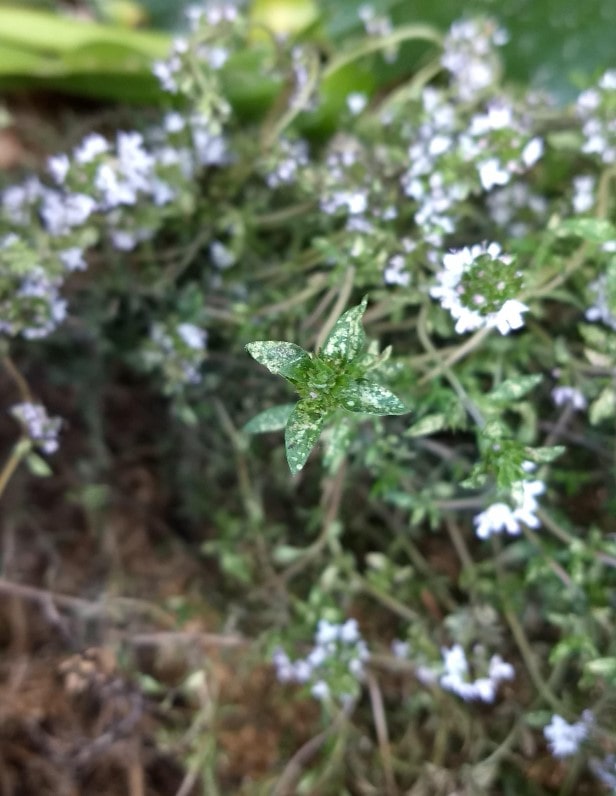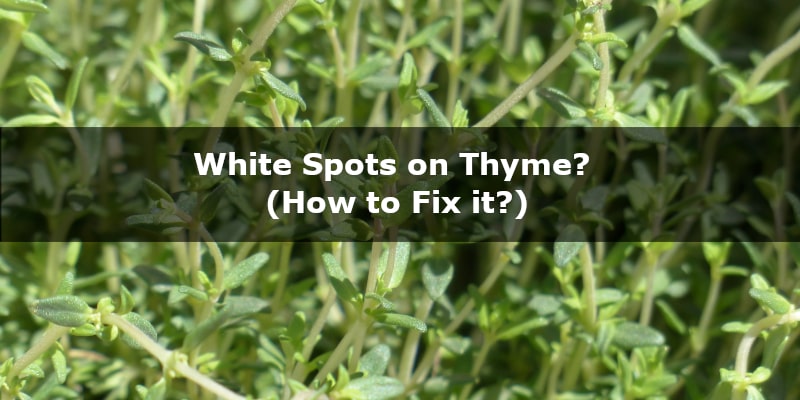A lot of people who grow thyme experience white spots on its leaves.
Is it serious? Can you treat eat? Is such thyme still edible? Keep on reading to find it out!
What are the White Spots on Thyme?
The white spots on thyme might be the cause of sucking insects, chlorine from water, scale insects, or powdery mildew. In most cases, you can treat these problems.
Sucking insects like thrips might be the cause of white spots on thyme. However, it’s also possible that chlorine that builds up in the soil causes white spots.
Depending on the cause, your thyme is perfectly good to eat.
Find out more causes, and how to deal with them, by reading the whole article.
Sucking Insects
Thyme is very rich in nectar and has a strong aroma. Because of that, it draws insects’ and pests’ attention to the foliage.
The most popular pests that feed on the leaves of thyme include thrips, spider mites, leafhoppers, and whiteflies. They have needle-like mouthparts which they insert in the leaves and withdraw liquids
These insects are tiny and are hard to notice, but their presence and actions are vividly reported on the leaves of thyme through the white spots spread about on the surface of the leaves.
White spots represent a loss of nutrients in the areas where these insects have fed. Thyme foliage with white spots means the foliage is still edible, but its flavor and potency are reduced.
To get rid of insects, you can had-pick them, or flush the entire foliage with running water, but you must ensure that the water does not accumulate in the soil.
You can also prevent insects by installing yellow sticky traps (buy here on Amazon), or keeping your thyme well watered, as thrips and leafhoppers like dry conditions.
The lush green and aromatic foliage of thyme should restore itself after insects disappear.
Chlorine From the Tap Water
If you water your thyme with city water, it often contains lots of chlorine that is used to kill microbes. Excess build-up of chlorine in the soil leaves white spots on the thyme leaves.

The solution for this is to repot the plant, gently removing some of the old potting mix from the roots and putting the plant back in a clean pot with new potting soil. After that, collect rainwater for the plants or let the water from the faucet sit in for a few hours before watering to dissipate chlorine.
Thyme with white spots from chlorine is safe to eat.
Scale Insects
Houseplant scale are gross-looking things that suck the sap out of the leaves and stems of thyme, resulting in stunted or deformed leaf growth, yellow or white spots on the leaves, brown pockmarks, or leaf drop.
Scale insects look like small brown dots or bumps, and they don’t move. They can range in size from barely visible to large bumps on a plant. Their color can range anywhere from brown to tan to white.
If the bugs on your houseplants are white and fuzzy and look more like mildew, those are mealybugs. Scale bugs on plants like to cluster, so they are very noticeable once the population gets large.
The damage caused by scale insects is not quick to occur, but it can still look pretty bad. If a houseplant scale infestation goes left untreated, the plant will die if you don’t do anything with that.
To get rid of scale insects on thyme plant, you need to apply neem oil (buy here on Amazon). It’s a natural insecticide for indoor plants, and it’s very effective for treating scale on houseplants. It helps with future pest prevention too.
Powdery Mildew
Your thyme leaves may have a fine, white dust. It can look like flour on the leaves’ surface. However, if you touch it, it won’t brush off. These spots are circular, and plenty of them appear on the upper leaf surface. You can see spaces in between.
Powdery mildew appears when a biotrophic fungus decides to feed off your thyme leaves. If fungus lands on your thyme leaves, they will start to germinate through spores.
The fungus can easily pierce thyme leaves. It lets them steal nutrients from the epidermal cells that cover your Mint leaves. Soon, fungus multiplies and forms new spores and filaments.
Again, applying neem oil is the best thing you can do. If you treat fungus, thyme is good to eat. Remember not to eat the leaves with white fungus.
Sources
ask2.extension.org, gardenanswers.com, gardenerd.com, getbusygardening.com, plantophiles.com, forum.nature-and-garden.com


